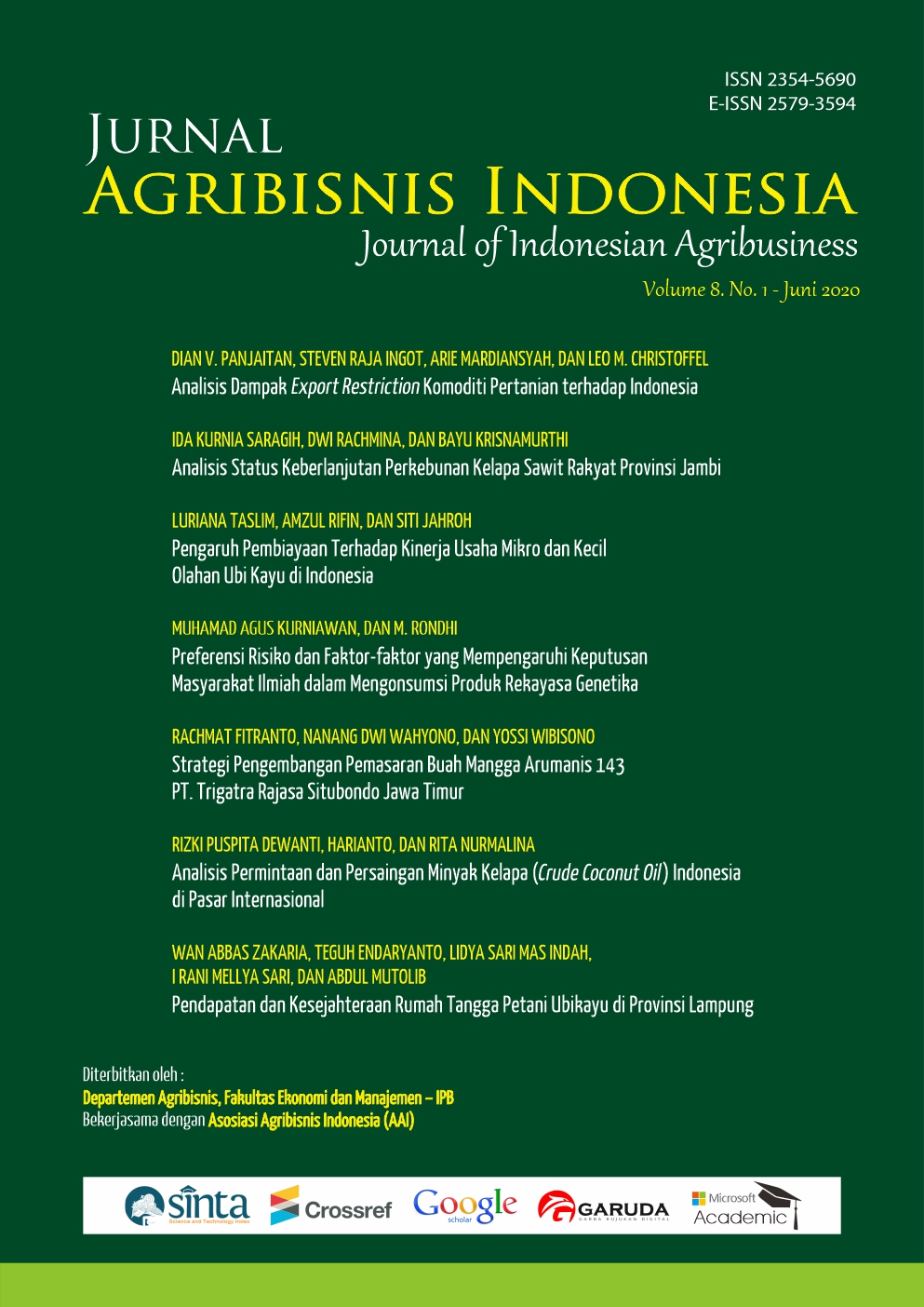Pendapatan dan Kesejahteraan Rumah Tangga Petani Ubikayu di Provinsi Lampung
Main Article Content
Abstract
This study aims to (1) analyze the level of income and (2) analyze the factors that influence the level of household welfare of cassava farmers. The study was conducted in Gunung Agung Village, Terusan Nunyai District, Central Lampung Regency with a survey method. The sample of farmers 78 respondents was taken by proportional stratified simple random sampling. Data analysis using quantitative descriptive methods include income analysis, welfare level analysis according to BPS and Sayogyo, and using a binary logit model. The results show that the source of household income of cassava farmers is increasingly diverse and leads to off and non-farm activities. Revenue from cassava farming has decreased but is still dominant. Based on BPS and Sayogyo criteria, most cassava farming households are in a decent and prosperous life group. The factors that influence the level of welfare of cassava farmers are the amount of work, cassava farming experience, and household income.
Downloads
Article Details
Jurnal Agribisnis Indonesia (JAI) is an Open Access Journal. The authors who publish the manuscript in this journal agree to the following terms:
Creative Commons License
JAI is licensed under a Creative Commons Attribution 4.0 International License. This permits anyone to copy, redistribute, remix, transmit, and adapt the work provided the original work and source are appropriately cited.
This means:
(1) Under the CC-BY license, authors retain ownership of the copyright for their article, but authors grant others permission to use the content of publications in Jurnal Agribisnis Indonesia in whole or in part provided that the original work is properly cited. Users (redistributors) of JAI are required to cite the original source, including the author's name, JAI as the initial source of publication, year of publication, volume number, issue, and Digital Object Identifier (DOI); (2) Authors grant JAI the right of first publication. Although authors remain the copyright owner.
References
Badan Pusat Statistik Provinsi Lampung. 2008. Lampung Dalam Angka 2008. http://lampung.bps.go.id. Diakses pada tanggal 3 Mei 2019
Badan Pusat Statistik Provinsi Lampung. 2014. Lampung Dalam Angka 2014. http://lampung.bps.go.id. Diakses pada tanggal 20 November 2019 pukul 20.00 WIB.
Badan Pusat Statistik. 2017. Indikator Kesejahteraan Rakyat 2017. Badan Pusat Statistik. Jakarta
Balakrishnama, Naidu. 2013. Impact of Agricultural Credit on Agricultural Production and Productivity. Dalam Asia Pasific Journal of Social Sciences, Vol 5 (1).
Chenery HB, Syrquin M. 1975. Pattern of Development 1950-1970. Word Bank Working Paper. Washington DC: World Bank.
Hastuti DHD dan A Rahim. 2008. Pengantar, Teori, dan Kasus Ekonomika Pertanian. Penebar Swadaya. Jakarta.
Igweoscar O, 2014. Effect of Contract Farming on Productity and Welfare of Cassava- Based Farmers in South Eastern Nigeria. European Journal of Business and Management Vol.6(7):334-339
Iqbal AM, Lestari DAH, Soelaiman A. 2014. Pendapatan dan Kesejahteraan Rumah Tangga Petani Ubi Kayu di Kecamatan Sukadana Kabupaten Lampung Timur. Jurnal Ilmu-ilmu Agribisnis 2(3): 246-25
Ginting, Salmina W. 2010. Transformasi Spasial dan Diversifikasi Ekonomi pada Wilayah Peri Urban di Indonesia. Jurnal Arsitektur dan Perkotaan. Koridor 1(7): 60-64.
Kahya M. 2012. Structural change, income distribution and poverty in ASEAN-4 countries [tesis]. Lund University.
Marisa dan Hutabarat, 1988. Keberagaman Sumber Pendpatan Rumah Tangga dan Dampaknya Terhadap Kemampuan Ekonomi Rumah Tangga Petani. Jurnal Agroekonomi 12(2) PERHEPI, Yokyakarta.
Mwaura, F. 2014. Efect of Farmer Group Membership on Agriculture Technology Adoption and Crop Productivity in Uganda. African Crop Science Journal 22 (4): 917- 927
Makki MF. 1994. Transformasi Struktur Perekonomian Indonesia dan Implikasinya terhadap Distribusi Pendapatan. Jakarta: Karya Ilmiah Program Perencanaan Nasional LPEM UI.
Mukhtar U (2012). Economic analysis of poutry-egg production in Bauchi local government area, Bauchi state, Nigeria. An M.Sc Thesis of Department of Agricultural Economics, Ahmadu Bello Univeristy Zaria.
Ndakularak E., Setiawina N D, dan Djayastra IK. 2014. Analisis Faktor-Faktor yang Mempengaruhi Kesejahteraan Masyarakat Kabupaten/Kota di Provinsi Bali. Jurnal Ekonomi dan Bisnis Universitas Udayana 3(3):140–153.
Rambe A, Hartoyo dan karsin ES. 2008. Analisis Alokasi Pengeluaran dan Tingkat Kesejahteraan Keluarga (Studi di Kecamatan Medan Kota, Sumatera Utara). Jurnal Ilmu Keluarga dan Konsumen 1(1):16-28
Rizal A, Rosidah, dan Fathira G. 2018. Potret Tingkat Kesejahteraan Rumah Tangga Pembudidaya Ikan di Ciganjur Jakarta Selatan. Jurnal Ilmu-ilmu Sosial dan Humaniora 20(1): 39-44
Roedjito, D. 1989. Kajian Penelitian Gizi. Jakarta. Mediyatama Sarana Perkasa
Sajogyo, T. 1997. Garis Kemiskinan dan Kebutuhan Minimum Pangan. LPSB-IPB. Bogor.
Saliem HP, Mayrowani, Sumaryanto GS. Hardono TB, Purwantini Y, Marisa, dan Hidayat D. 2005. Pengaruh Pola Diversifikasi Tanaman Pangan Terhadap Pendapatan Rumah Tangga Petani. Pusat Studi Ekonomi Pertanian. PSE Bogor, Bogor.
Syakina FN, Indriani, Y dan Affandi MI, 2019. Analisis Pendapatan, Kesejahteraan Rumah Tangga dan Strategi Pengembangan Usaha Budidaya Lele di Kecamatan Natar Kabupaten Lampung Selatan. Jurnal Ilmu-ilmu Agribisnis 7(1):60-67
Yunus, Hadi Sabari. 2008. Dinamika Wilayah Peri-Urban: Determinan Masa Depan Kota. Yokyakarta: Pustaka Pelajar
Zakaria, WA. 2018. Model Kelembagaan Kemitraan Agribisnis Ubikayu di Provinsi Lampung. Laporan Hibah Profesor. Universitas Lampung. Bandar Lampung.

